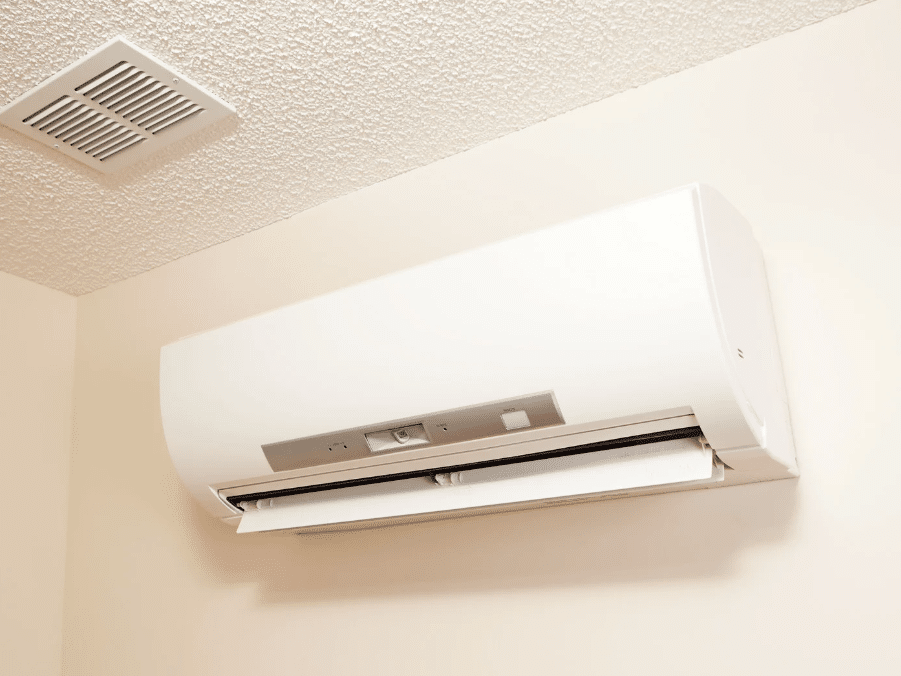Expensive Initial Price:
The high initial cost of ceiling-mounted mini-split air conditioners is one of their biggest disadvantages. Generally speaking, these systems are more costly to buy than conventional window or wall-mounted units. The equipment itself, and the ceiling cassette in particular, is expensive since it has sophisticated features including inverter technology, smart controls, and multidirectional airflow. Professional installation fees may further raise the final cost, particularly if the installation calls either altering the ceiling or strengthening the structure to hold the unit. This upfront expense may be a big turnoff for homeowners on a limited budget.
A Difficult Installation Procedure:
Even though ductwork is not necessary for ceiling-mounted mini-split systems, installing them can still be difficult and time-consuming. Ceiling cassettes need to be recessed into the ceiling, in contrast to wall-mounted units, which just require a little hole for the refrigerant line. To make sure the ceiling structure can support the unit and its weight, meticulous design is needed. Installation could not be feasible without major adjustments in situations where ceilings are too low or there is not enough room between the ceiling and the roof. Because of its intricacy, hiring skilled HVAC experts is frequently required, which raises labour costs and may cause the project’s deadline to be delayed.
Limited Applicability in Certain Buildings:
Not all kinds of buildings or areas can accommodate ceiling-mounted mini-split systems. They are not practicable for homes with low ceilings or buildings with little attic or crawl space since they need a deep enough ceiling to accommodate the cassette unit. Installing a ceiling cassette in an older building with intricate ceilings or structural limits could detract from the building’s attractiveness or potentially jeopardize its structural integrity. Because of this, the adaptability of these systems may be limited, and homeowners or businesses in such settings may need to think about other cooling options.
Difficulties with Maintenance:
Accessing the units for regular cleaning or servicing can be difficult, even though ceiling-mounted mini-split systems often require less care than conventional ducted systems. A ladder or specialized tools are frequently needed to clean the filters or inspect the device because the cassette is level with the ceiling. This may be inconvenient, particularly for homeowners who like doing their repairs. Furthermore, any problems with the drainage system or refrigerant lines would necessitate partially disassembling the ceiling, which could result in more expensive repairs and longer service periods.
Greater Repair Expenses:
Because of their sophisticated components and innovative technology, ceiling-mounted mini-split air conditioners may require more expensive repairs in the event of a malfunction. For instance, it can be costly to repair or replace the inverter system, sensors, or multidirectional airflow mechanisms if they malfunction. Costs may also increase if components of the ceiling must be disassembled to access the unit for repairs. When compared to easier and more affordable air conditioning options, ceiling cassettes may seem less desirable because of their higher maintenance and repair costs.
Insufficient Portability:
Mini-split air conditioners positioned on the ceiling are permanently fixed, in contrast to window or portable models. It is difficult to move a unit once it is set into the ceiling. Because they can’t take the system with them to a new property, renters or those who move around a lot may find this lack of mobility to be a disadvantage. Furthermore, because these systems are permanent, they may need to be removed and reinstalled during any major home remodelling or move, which may be expensive and time-consuming.
Aesthetic Constraints in Certain Designs:
Despite its discrete design, ceiling-mounted mini-splits can occasionally detract from a room’s visual appeal. In areas with exposed wooden beams, elaborate ceiling patterns, or other architectural elements, installing a ceiling cassette could take away from the overall aesthetic. Even though the units are typically low-profile and elegant, they could still be noticeable in environments that are very decorative or minimalist, which could limit the adaptation capacity of the design. These units might not be the greatest option for people who value effortless integration into the design of their house.
Some Models’ Noise Levels:
Some versions may make perceptible noise, especially if the system is operating at full capacity or has not been properly maintained, even though the majority of ceiling-mounted mini-splits function silently. Older models or improperly fitted units may occasionally exhibit vibrations or fan noise, which can be uncomfortable in calm spaces like offices, libraries, or bedrooms. Even though this problem is uncommon, it emphasizes how crucial it is to choose high-quality models and guarantee expert installation to reduce any possible noise disturbances.
Limited Heating Performance in Extreme Cold:
Even while a lot of mini-splits put on the ceiling can heat, they may not work as well in very cold climates. Heat pump technology, which moves heat from outdoor air into inside spaces, is the foundation of mini-split systems. The effectiveness of this procedure may decline in areas where external temperatures drop considerably, resulting in increased energy use and maybe insufficient heating. In colder climates, homeowners might need to add a space heater or furnace to their mini-split system, which raises overall expenses and energy consumption.
Frequently Asked Questions:
1. Is It Possible For Me To Install My Own Air Conditioner?
Window units can be installed by do-it-yourselfers, but central and ductless systems usually need professional assistance because of their complexity and safety issues. Ineffective performance and void warranties might result from improper installation. To guarantee correct installation and operation, it is advised to speak with an HVAC specialist.
2. How Can I Pick An Air Conditioner Of The Proper Size?
Efficiency depends on selecting the right size unit. BTUs are used to assess cooling capacity; larger rooms need higher BTUs. To ensure the best performance, an HVAC professional can calculate the load and choose the right size based on the insulation, local climate, and the layout of your home.


